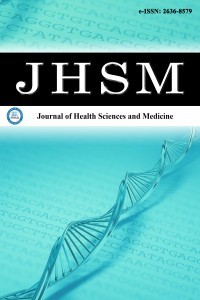1.
Fiore E, Van Tyne D, Gilmore MS. Pathogenicity of enterococci. <em>Microbiol Spectrum</em>. 2019;7(4):3-53.
2.
Rice LB. Enterococcal physiology and antimicrobial resistance: the streetlight just got a little brighter. <em>mBio</em>. 2021;12(1): e03511-e03520. doi:10.1128/mBio .03511-20
3.
Aung MS, Urushibara N, Kawaguchiya M, et al. Antimicrobial resistance, virulence factors, and genotypes of <em>Enterococcus faecalis</em> and <em>Enterococcus faecium</em> clinical ısolates in Northern Japan: identification of optrA in ST480 <em>E. faecalis</em>. <em>Antibiotics</em>. 2023;12(1):108. doi:10.3390/antibiotics12010108
4.
Ghalavand Z, Alebouyeh M, Ghanati K, et al. Genetic relatedness of the <em>Enterococcus faecalis</em> isolates in stool and urine samples of patients with community-acquired urinary tract infection. <em>Gut Pathog</em>. 2020;12:42. doi:10.1186/s13099-020-00380-7
5.
Baylan O. Enterokok enfeksiyonlarında immünopatogenez ve virülans faktörleri. <em>Nobel Med</em>. 2019;15(2):5-16.
6.
Moussa AA, Nordin AF, Hamat RA, Jasni AS. High level aminoglycoside resistance and distribution of the resistance genes ın <em>Enterococcus faecalis</em> and <em>Enterococcus faecium</em> from teaching hospital ın Malaysia. <em>Infect Drug Resist.</em> 2019;12:3269-3274.
7.
Zheng J-X, Wu Y, Lin Z-W, et al. Characteristics of and virulence factors associated with biofilm formation in clinical <em>Enterococcus faecalis</em> isolates in China. <em>Front. Microbiol</em>. 2017;8:2338. doi: 10.3389/fmicb.2017.02338
8.
Ramos BA, Manta MM, da Silva, SM, et al. Virulence factors and biofilm formation in vancomycin resistant <em>Enterococcus faecalis</em> and <em>Enterococcus faecium</em> isolates in Brazil. <em>Advanc Microbiol.</em> 2023;13(6):299-314. doi:10.4236/aim.2023.136019
9.
Guzman Prieto AM, Schaik WV, Rogers MRC, et al. Global emergence and dissemination of <em>Enterococci</em> as nosocomial pathogens: attack of the clones? <em>Front Microbiol</em>. 2016;7:1-15.
10.
Vergis EN, Shankar N, Chow JW, et al. Association between the presence of <em>Enterococcal </em>virulence factors gelatinase, hemolysin and <em>Enterococcal</em> surface protein and mortality among patients with bacteremia due to <em>Enterococcus faecalis</em>. <em>Clin Infect Dis</em>. 2002;35(5):570-575.
11.
Creti R, Imperi M, Bertuccini L, et al. Survey for virulence determinants among <em>Enterococcus faecalis</em> isolated from different sources. <em>J Med Microbiol</em>. 2004;53(Pt 1):13-20.
12.
Samani RJ, Tajbakhsh E, Momtaz H, Samani.; Prevalence of virulence genes and antibiotic resistance pattern in <em>Enterococcus faecalis</em> isolated from urinary tract infection in Shahrekord, Iran. <em>Rep Biochemistr Mol Biol. </em>2021;10(1):50-59.
13.
Hallgren A, Claesson C, Saeedi B, et al. Molecular detection of aggregation substance, enterococcal surface protein, and cytolysin genes and in vitro adhesion to urinary catheters of <em>Enterococcus faecalis</em> and <em>E. faecium</em> of clinical origin. <em>Int J Med Microbiol</em>. 2009;299(5):323-332.
14.
Clinical and laboratory standart institue performance standarts for antimicrobial susceptibility testing. Nighteen International Supplement. 2009. M100-S19. CLSI, Wayne, PA.
15.
European centre for disease prevention and control. antimicrobial resistance surveillance in Europe 2014. Annual Report of the European antimicrobial resistance surveillance network (EARS-Net). Stockholm: ECDC; 2015:1-85.
16.
European Centre for Disease Prevention and Control. Antimicrobial resistance in the EU/EEA (EARS-Net) - Annual Epidemiological Report 2019. Stockholm: ECDC; 2020:1-28.
17.
European Centre for Disease Prevention and Control. Antimicrobial resistance in the EU/EEA (EARS-Net) - Annual Epidemiological Report 2021. Stockholm: ECDC; 2022.
18.
Horner C, Mushtag S, Hope R, et al. Replacement of <em>Enterococcus faecalis</em> by <em>Enterococcus faecium</em> as the predominant <em>Enterococcus</em> in UK bacteraemias. JAC <em>Antimicrob Resist</em>. 2021. doi:10.1093/jacamr/dlab185
19.
Gupta S, Srivastava P, Yadav S, et al. Vancomycin-Resistant Enterococci causing bacteriuria in hospitalized patients from Northwest India. Website: www.journaldmims.com 2020. doi: 10.4103/jdmimsu.jdmimsu_69_20
20.
Das A, Banerjee T, Anupurba S. Susceptibility of nitrofurantoin and fosfomycin against outpatient urinary isolates of multidrug-resistant Enterococci over a period of 10 years from India. <em>Microbial Drug Resistance</em>. 2019;26(12):1-7. doi:10.1089/mdr. 2019.0044
21.
Kafil HS, Mobarez AM. Spread of <em>Enterococcal</em> surface protein in antibiotic resistant Enterococcus faecium and <em>Enterococcus faecalis</em> isolates from urinary tract infections.<em> Open Microbiol J</em>. 2015;9:14-17.
22.
Kutlu o, Arabacı Ç. Antibiotic susceptibility pattern of <em>Enterococcus</em> isolates in a five year period at a tertiary care hospital. <em>J Surg Med</em>. 2019;3(9):644-647.
23.
Savcı Ü, Şahin M, Eser B. Klinik örneklerden izole edilen <em>Enterococcus faecalis</em> ve <em>Enterococcus faecium</em> suşlarında antibiyotik dirençlerinin değerlendirilmesi. <em>J Health Sci Med</em>. 2018;1(1):4-8.
24.
Şimşek M. İdrar kültürlerinden izole edilen enterokok suşlarının tür dağılımları ve antibiyotik duyarlılıkları. <em>Kocatepe Med J</em>. 2019;20(1):177-182.
25.
Baylan O, Nazik H, Bektöre B, ve ark. Üriner enterokok izolatlarının antibiyotik direnci ile virülans faktörleri arasındaki ilişki. <em>Mikrobiyol Bul</em>. 2011;45(3):430-445.
26.
Zheng J, Bai B, Lin Z, et al. Characterization of biofilm formation by <em>Enterococcus faecalis</em> isolates derived from urinary tract infections in China. <em>J Med Microbiol</em>. 2018;67(1):60-67.
27.
Zheng JX, Wu Y, Lin Z, et al. Characteristics of and virulence factors associated with biofilm formation in clinical <em>Enterococcus faecalis</em> isolates in China. <em>Front Microbiol</em>. 2017;8:1-9.
28.
Hashem Y, Abdelrahman KA, Aziz R. Phenotype-genotype correlations and distribution of key virulence factors in <em>Enterococcus faecalis</em> isolated from patients with urinary tract infections. <em>Infect Drug Resist</em>. 2021:14;1713-1723.
29.
Gök ŞM, Dağı HT, Kara F. Klinik örneklerden izole edilen <em>Enterococcus faecium</em> ve <em>Enterococcus faecalis</em> izolatlarının antibiyotik direnci ve virülans faktörlerinin aras¸tırılması. <em>Mikrobiyol Bul</em>. 2020;54(1):26-39.
30.
Mete E, Kaleli İ, Cevahir N ve ark. Enterokok türlerinin virulans faktörlerinin aras¸tırılması. <em>Mikrobiyol Bul.</em> 2017;51(2):101-114.

